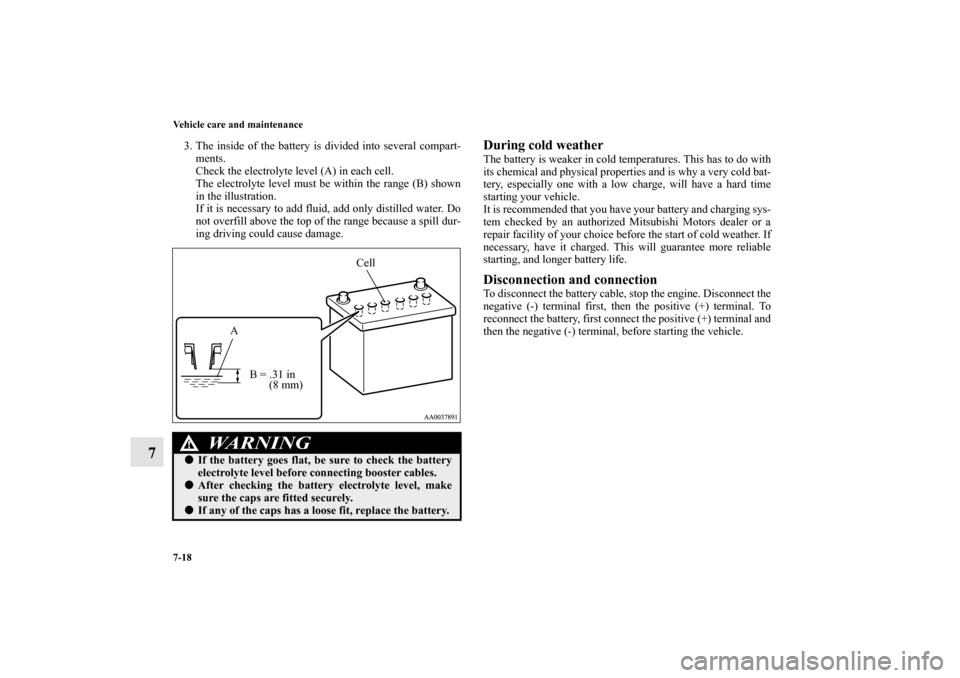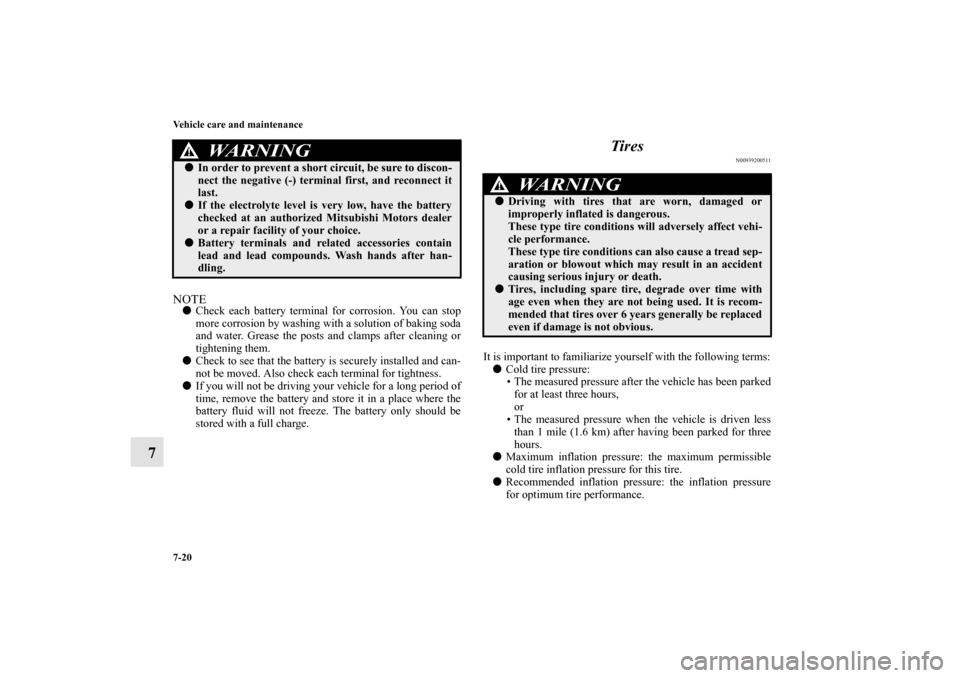Page 432 of 514
Vehicle care and maintenance
7-5
7
Support the engine hood with the hood prop. Insert the hood
prop securely in the opening under the hood marked with an
arrow.
To closeUnlatch the prop from the engine hood and put it back in its
retainer.
Slowly lower the engine hood about 12 inches (30 cm), then let
it drop from its own weight. NOTE�If this does not close the engine hood properly, drop it
again from a slightly higher position.
CAUTION
!�Always insert the support prop into the hole spe-
cially made for it. Propping the engine hood at any
other place could cause the prop to slip out and lead
to an accident. �The hood prop can fall out if the hood is lifted by a
strong wind.
CAUTION
!�Be careful not to trap your hands or fingers when
closing the engine hood.
BK0102600US.book 5 ページ 2009年3月30日 月曜日 午後2時2分
Page 445 of 514

7-18 Vehicle care and maintenance
7
3. The inside of the battery is divided into several compart-
ments.
Check the electrolyte level (A) in each cell.
The electrolyte level must be within the range (B) shown
in the illustration.
If it is necessary to add fluid, add only distilled water. Do
not overfill above the top of the range because a spill dur-
ing driving could cause damage.
During cold weatherThe battery is weaker in cold temperatures. This has to do with
its chemical and physical properties and is why a very cold bat-
tery, especially one with a low charge, will have a hard time
starting your vehicle.
It is recommended that you have your battery and charging sys-
tem checked by an authorized Mitsubishi Motors dealer or a
repair facility of your choice before the start of cold weather. If
necessary, have it charged. This will guarantee more reliable
starting, and longer battery life.Disconnection and connectionTo disconnect the battery cable, stop the engine. Disconnect the
negative (-) terminal first, then the positive (+) terminal. To
reconnect the battery, first connect the positive (+) terminal and
then the negative (-) terminal, before starting the vehicle.
WA R N I N G
!�If the battery goes flat, be sure to check the battery
electrolyte level before connecting booster cables.�After checking the battery electrolyte level, make
sure the caps are fitted securely.�If any of the caps has a loose fit, replace the battery.
Cell
A
B = .31 in
(8 mm)
BK0102600US.book 18 ページ 2009年3月30日 月曜日 午後2時2分
Page 447 of 514

7-20 Vehicle care and maintenance
7
NOTE�Check each battery terminal for corrosion. You can stop
more corrosion by washing with a solution of baking soda
and water. Grease the posts and clamps after cleaning or
tightening them.
�Check to see that the battery is securely installed and can-
not be moved. Also check each terminal for tightness.
�If you will not be driving your vehicle for a long period of
time, remove the battery and store it in a place where the
battery fluid will not freeze. The battery only should be
stored with a full charge.
Tires
N00939200511
It is important to familiarize yourself with the following terms:
�Cold tire pressure:
• The measured pressure after the vehicle has been parked
for at least three hours,
or
• The measured pressure when the vehicle is driven less
than 1 mile (1.6 km) after having been parked for three
hours.
�Maximum inflation pressure: the maximum permissible
cold tire inflation pressure for this tire.
�Recommended inflation pressure: the inflation pressure
for optimum tire performance.
�In order to prevent a short circuit, be sure to discon-
nect the negative (-) terminal first, and reconnect it
last.�If the electrolyte level is very low, have the battery
checked at an authorized Mitsubishi Motors dealer
or a repair facility of your choice.�Battery terminals and related accessories contain
lead and lead compounds. Wash hands after han-
dling.
WA R N I N G
!
WA R N I N G
!�Driving with tires that are worn, damaged or
improperly inflated is dangerous.
These type tire conditions will adversely affect vehi-
cle performance.
These type tire conditions can also cause a tread sep-
aration or blowout which may result in an accident
causing serious injury or death.�Tires, including spare tire, degrade over time with
age even when they are not being used. It is recom-
mended that tires over 6 years generally be replaced
even if damage is not obvious.
BK0102600US.book 20 ページ 2009年3月30日 月曜日 午後2時2分
Page 459 of 514

7-32 Vehicle care and maintenance
7
NOTE�To meet government regulations and promote cleaner air,
your vehicle is equipped with an onboard diagnostic sys-
tem (OBD). The engine electronic control module that
controls OBD functions stores various data (especially
about the exhaust emissions). This data will be erased if
the battery cable is disconnected, which could make a
rapid diagnosis difficult. Do not disconnect the battery
cable when the engine malfunction indicator (“SERVICE
ENGINE SOON” or “Check engine light”) is on.Spark plugs
N00940900127
Spark plugs must fire properly for good engine performance
and emission-control.
Do not reuse them by cleaning or regapping. Change them at
the mileage listed in the “WARRANTY AND MAINTE-
NANCE MANUAL”.
Your vehicle may be equipped with iridium tipped spark plugs,
which are identified by marks on the ceramic. They do not
require replacement as frequently as the conventional type
spare plug and will last much longer.NOTE�Use the spark plugs listed under “Engine specifications”
on page 9-6 or plugs that are exactly the same. Other
plugs could cause engine damage, performance problems
or radio noise.Fuel hoses
N00941000011
Check the hose surfaces for any heat and mechanical damage,
hard and brittle rubber, cracking, tears, cuts and abrasions. Payspecial attention to the hoses closest to high heat sources such
as the exhaust manifold. Check all the hose connections, such
as clamps and couplings, to make sure they are secure and that
there are no leaks. If you see any wear or damage, replace the
hoses immediately.
Fuel system (tank, pipe line and connection, and
fuel tank filler tube cap)
N00941300131
Check these regularly for damage or leaks in the fuel lines and
connections. Check the fuel tank filler tube cap for damage or
looseness. Pay special attention to the fuel lines closest to high
heat sources such as the exhaust manifold.Evaporative emission control system (except
evaporative emission canister)
N00941400116
If the fuel-vapor vent line is clogged or damaged, the fuel-
vapor mixture will escape, polluting the air.
Have the system checked at an authorized Mitsubishi Motors
dealer at the mileage specified in the “WARRANTY AND
MAINTENANCE MANUAL”.
WA R N I N G
!�If you see a fuel leak or if you smell fuel, do not run
the engine. Any spark (including from the ignition),
flame or smoking material could cause an explosion
or fire. Call an authorized Mitsubishi Motors dealer
or a repair facility of your choice for assistance.
BK0102600US.book 32 ページ 2009年3月30日 月曜日 午後2時2分
Page 470 of 514
Vehicle care and maintenance
7-43
7
5. Use the fuse location diagrams and the matching tables, to
check the fuse that is related to the problem. If the fuse is
not blown, something else must be causing the problem.
Contact an authorized Mitsubishi Motors dealer or a
repair facility of your choice to have the problem checked.6. Insert a new fuse of the same capacity securely into the
appropriate slot. A- Fuse is OK
B- Blown fuse
CAUTION
!�Never use a fuse with a capacity greater than the one
listed or any substitute, such as wire, foil etc. This
would cause the circuit wiring to heat up and could
cause a fire. �If the replacement fuse blows again after a short
time, have the electrical system checked by an
authorized Mitsubishi Motors dealer or a repair
facility of your choice to find and correct the cause.
BK0102600US.book 43 ページ 2009年3月30日 月曜日 午後2時2分